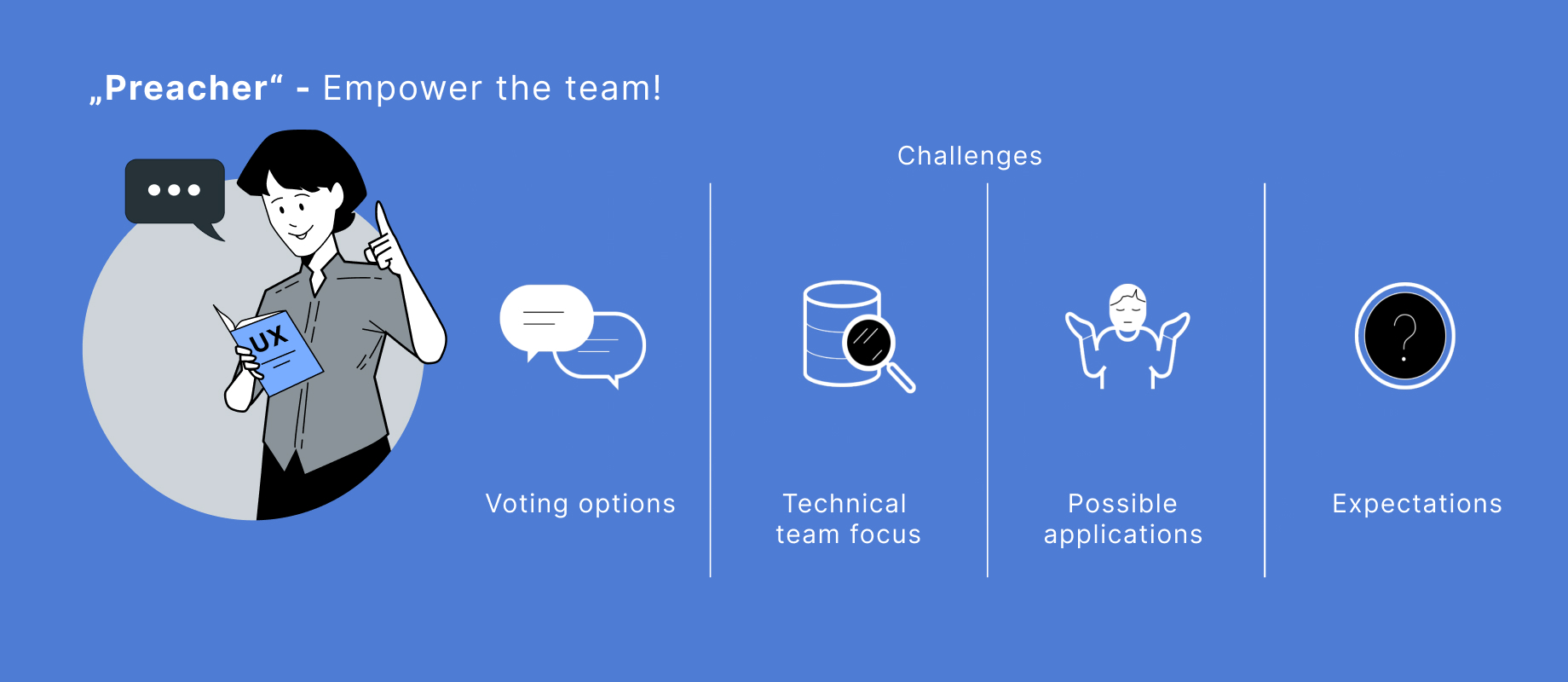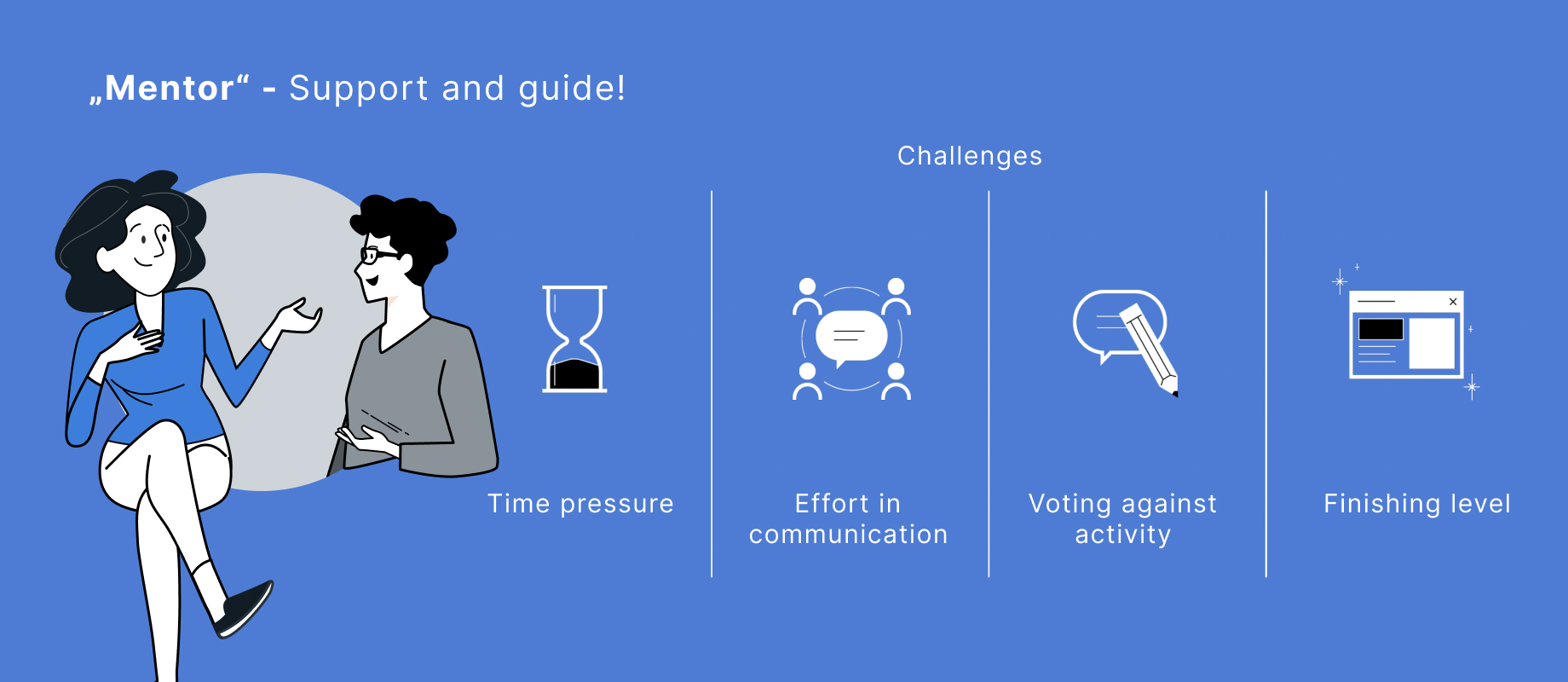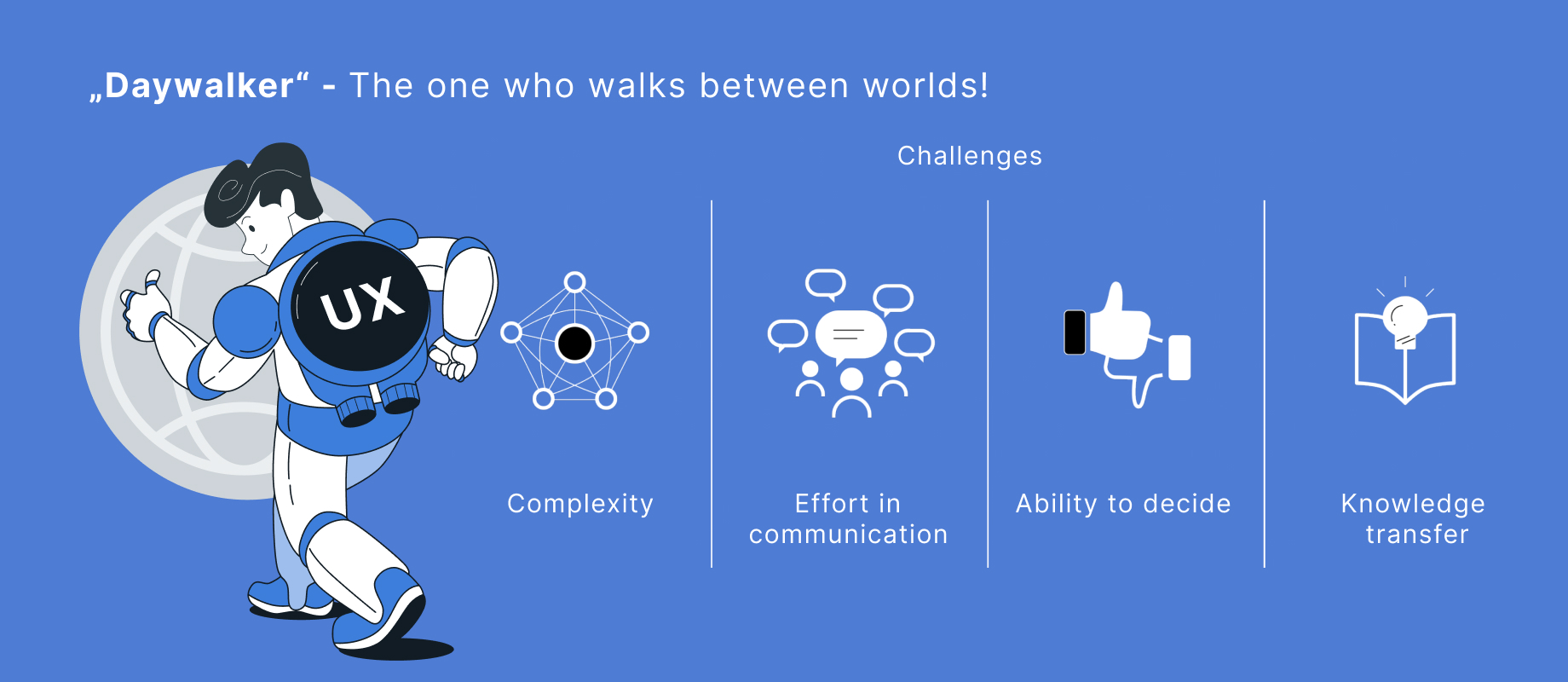
In the world of software development, there is an ongoing debate about how to seamlessly integrate the user experience (UX) into agile methods such as scrum.
UX and scrum seem at first glance like two worlds that do not fit together due to differing characteristics and priorities. Our new blog post explains how collaboration between UX and scrum can be successful.
In order to achieve a realistic illustration, we will first outline a typical project setup:
In a project with a duration of one year, the focus is on four developers, a product owner (internal or external) and a scrum master. The course of the project is characterised by a structured framework that manifests itself in two-week sprints.
Each sprint raises new questions and answers, while the overall picture of the project continues to evolve.
Despite this clear structure, the use of UX in this context can be characterised by different circumstances. We therefore present four different scenarios, each of which highlights different challenges and opportunities for the use of UX.
SCENARIO 1: "Preacher" - empower the team!

In a project scenario with a very limited budget and little user interaction, challenges can lie in unclear expectations and possible applications because the product owner is not prepared for collaboration with the UX, for example.
When and where should UX be integrated into the development process? And what specific contributions can UX designers make so that they add value to the project?
Another obstacle is the limited coordination possibilities between the UX team and the developers, which can lead to misunderstandings.
These uncertainties can lead to delays and ineffective utilisation of limited resources.
To counteract these problems, the role of the "preacher" can be taken on by UX professionals.
The "preacher" acts as a supporting force, especially when the team is very technically focussed and has limited experience in UX, but urgently needs an incentive to focus more on the needs of the users.
They act as an advocate of the user-centred way of working and strives to raise awareness within the team of the relevance of UX.
This can take place by conducting training courses for product owners and the development team, in order to demonstrate the possibilities and methods of a user-centred way of working. The training sessions can use various tools such as standardised questionnaires, interview guidelines, persona templates and UI libraries to provide team members with practical tools.
The "preacher" can also provide concepts, research results and designs. However, certain rules must be defined to ensure that these inputs works effectively in a sprint rhythm.
As a "preacher", the UX professional is a central point of contact for the entire team and should therefore have a strong presence, especially in meetings. It is important that they create a relaxed atmosphere and avoid fingerpointing.
In order to establish the UX designer as a positive role in the team, informal meetings are important. In these meetings, the "preacher" can use good examples from other projects or products to illustrate what has worked well in the past and how UX can offer added value. This helps to promote understanding and acceptance of the importance of UX in the team and strengthen collaboration.
SCENARIO 2: "Mentor" - support and guide!

The next scenario is characterised by a tight budget and a high workload that needs to be managed.
The challenges are manifold: there is a lot of time pressure, as the development is dependent on the input and is continually progressing.
The communication effort is high, as effective coordination and prioritisation of topics is required. It is important to strike a balance between coordination and actual activity, as the team will also want to provide input actively.
In addition, there is a risk that too much coordination will not leave enough time for the necessary work tasks. Another aspect is the level of elaboration, with many UX professionals tending to get lost in the detail, which can impair efficiency.
The role of the "mentor" is the ideal way to fulfil these tasks.
It is crucial that the "mentor" has a wealth of experience as a UX designer.
The "mentor" must know which tasks require their own attention and which can be delegated to the scrum team. Regular and intensive collaboration with the product owner, coupled with a clear prioritisation of topics and the necessary research, is essential.
It is advisable to agree a fixed date between the UX designer and product owner.
The "mentor" should actively participate in refinements and reviews in order to clarify open questions at an early stage and take up feedback from stakeholders.
In addition, the introduction of supporting tools is not only useful for the team but also of great benefit to designers themselves.
In reality such projects require skilful juggling of available resources and a constant search for solutions that do justice to all parties involved.
Through the support of the "mentor", team members have the opportunity to continuously develop their skills in the area of UX.
Accordingly, the role of the "mentor" could in future focus on empowering the team to carry out UX work independently instead of doing it for the team. This assumes that the team developing the front end is willing to take on this responsibility. An important aspect of this is understanding and empathising with the role of the developers in order to provide effective support and guidance.
SCENARIO 3: "Maker" - doing instead of talking!

In the third scenario, which is characterised by a sufficient budget and a lack of dependencies, there are nevertheless a number of challenges that need to be addressed.
A large budget goes hand in hand with a lot of time, which in turn means that a large number of tasks can be accomplished. One challenge is to ensure the necessary transparency. The urgent need to integrate UX into the sprint rhythm contributes to this challenge, as results are expected at the end of each sprint. For user testing, it is necessary to plan fixed time slots in order to find appointments with them within the sprints.
Due to the lack of dependencies on other projects, there is also a lack of professional exchange with the UX team, which is an important asset for UX designers.
The role of the "maker" is directly dedicated to UX tasks with a hands-on mentality and provides practical solutions. This character works particularly effectively when quick results are required and the team needs direct support in the implementation of UX topics.
The "maker" within the development team is central to the successful integration of UX tasks into agile projects. A key aspect of this role is to be fully integrated into the dynamics and way of working of the development team. This includes participating in various team meetings, such as dailies and sprint refinements, in order to be continuously informed about progress and requirements.
Active participation in the development team's sprint events is also an important aspect. Through this participation, the "maker" increases their visibility in the sprint and becomes part of the sprint rhythm. This enables close collaboration with the team members and effective coordination of the UX tasks with the other development activities.
To ensure that the UX tasks are appropriately considered and prioritised, it is crucial to make them transparent in the backlog and sprint. The UX tasks can exist both as subtasks within other stories and as independent stories in the backlog. Independent stories serve as the basis for development and require a lead time for planning and implementation.
UX professionals and product owners need to work hand-in-hand and clearly communicate user requirements and dependencies in order to ensure visual planning.
A crucial function of the "maker" is to plan the UX topics early on in the future sprints and ensure that they are appropriately integrated into the sprint planning. It is important not to plan too far in advance, but to work in an agile manner and adapt with flexibility to new requirements.
It is also advisable to establish a UX review in line with the definition of done.
It is helpful to use a user story map and define a clear, minimum viable product (MVP). The user story mapping technique enables the scrum team and UX to better understand and roughly capture the required functionalities. This rough mapping makes it possible to gradually refine the details over the course of the sprints, while at the same time clearly differentiating which functions are part of the MVP and which are not.
Overall, the role of the "maker" helps to increase the acceptance and understanding of the importance of UX in the development team. Close collaboration with team members and transparent integration of UX tasks into the development team's workflows ensures that UX aspects are appropriately considered and implemented to ensure an optimal user experience.
SCENARIO 4: "Daywalker" - the one who walks between worlds!

The challenges in the fourth scenario, which is characterised by sufficient budget and dependencies on other projects, are complex.
As product complexity increases, the communication effort increases, as different teams are involved in the development of the product and need to be included in the planning. At the same time decision making is more difficult as strategic decisions have to be made that can have an impact on several areas. Another key aspect is knowledge transfer, which must take place continuously to ensure that relevant knowledge is always shared and that all team members are up to date.
The "daywalker", who walks between worlds, plays a special role in product development. Their task is to build bridges between different teams, technologies and projects.
Their presence covers all aspects of the project, they have access to insights hidden from the other roles and participates in the decision-making process.
One of the most important functions of the "daywalker" is to work closely with software architects in order to develop a better understanding of the technical side of the product and thus influence future architectural decisions. This involves not only their own area of expertise, but also coordination between backend and frontend teams.
To ensure a consistent user experience, the "daywalker" establishes regular UX sync meetings at which joint development opportunities are discussed.
By sharing research results and participating in reviews by other teams, it helps to create synergies and promote an overarching understanding of the overall product. It also makes sense to create and utilise a shared pool of test subjects.
Filters and main navigation tools are common issues where collaboration allows existing solutions to be utilised effectively rather than reinvented.
In addition, the "daywalker" is responsible for establishing a design system that will serve as the basis for a homogenised product. To bring all these different areas together, the "daywalker" acts as a link and helps to ensure that the product offers a clear and consistent user experience even with increasing complexity.
Despite their apparent incompatibility, UX and Scrum offer the opportunity of fruitful collaboration in software development.
The four roles presented here provide different approaches to the integration of UX in a wide variety of project scenarios: from the advisory role of the "preacher" to the role of the "mentor", which guides the team and occasionally intervenes; the active, fully integrated role of the "maker" to the integrated "daywalker", who is present in many projects and is rarely able to take action themselves.
Ultimately, a good integration of UX is achieved above all through active presence in the team and the associated visualisation of the relevance of user experience design.
This integration can be measured using various criteria, such as the number of UX tasks in the backlog and sprint backlog. In addition, regular status queries from developers regarding collaboration with the UX team and the recording of feedback in retrospectives can be important indicators. Ultimately, this measurability makes it possible to better understand the degree of integration of UX into the team and make adjustments if necessary.
However, regardless of the specific challenges and opportunities we face, the user should always take centre stage. After all, it is ultimately the users for whom the product is being developed. Resources such as money and lifetime determine which options are available to us in order to fulfil their needs in the best possible way.
It is important to choose the approach that best suits the situation at hand. In doing so, you should be aware that there is no universal solution, but that the right formats must be found and utilised.
Agile methods such as scrum definitely offer a good opportunity to involve all team members in the development process and strengthen collaboration. By placing the principles of user-centricity at the centre of the work and focusing on the needs and expectations of the users, it is possible to ensure that the product offers an optimal user experience.
IT Consulting
Learn more about our services